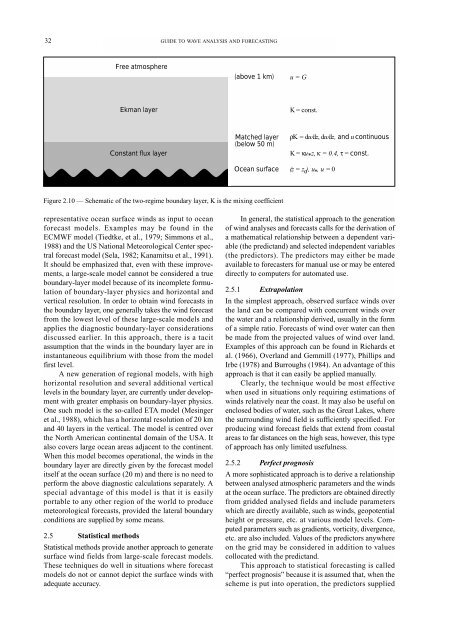GUIDE WAVE ANALYSIS AND FORECASTING - WMO
GUIDE WAVE ANALYSIS AND FORECASTING - WMO
GUIDE WAVE ANALYSIS AND FORECASTING - WMO
You also want an ePaper? Increase the reach of your titles
YUMPU automatically turns print PDFs into web optimized ePapers that Google loves.
32<br />
Free atmosphere<br />
Ekman layer<br />
Constant flux layer<br />
representative ocean surface winds as input to ocean<br />
forecast models. Examples may be found in the<br />
ECMWF model (Tiedtke, et al., 1979; Simmons et al.,<br />
1988) and the US National Meteorological Center spectral<br />
forecast model (Sela, 1982; Kanamitsu et al., 1991).<br />
It should be emphasized that, even with these improvements,<br />
a large-scale model cannot be considered a true<br />
boundary-layer model because of its incomplete formulation<br />
of boundary-layer physics and horizontal and<br />
vertical resolution. In order to obtain wind forecasts in<br />
the boundary layer, one generally takes the wind forecast<br />
from the lowest level of these large-scale models and<br />
applies the diagnostic boundary-layer considerations<br />
discussed earlier. In this approach, there is a tacit<br />
assumption that the winds in the boundary layer are in<br />
instantaneous equilibrium with those from the model<br />
first level.<br />
A new generation of regional models, with high<br />
horizontal resolution and several additional vertical<br />
levels in the boundary layer, are currently under development<br />
with greater emphasis on boundary-layer physics.<br />
One such model is the so-called ETA model (Mesinger<br />
et al., 1988), which has a horizontal resolution of 20 km<br />
and 40 layers in the vertical. The model is centred over<br />
the North American continental domain of the USA. It<br />
also covers large ocean areas adjacent to the continent.<br />
When this model becomes operational, the winds in the<br />
boundary layer are directly given by the forecast model<br />
itself at the ocean surface (20 m) and there is no need to<br />
perform the above diagnostic calculations separately. A<br />
special advantage of this model is that it is easily<br />
portable to any other region of the world to produce<br />
meteorological forecasts, provided the lateral boundary<br />
conditions are supplied by some means.<br />
2.5 Statistical methods<br />
Statistical methods provide another approach to generate<br />
surface wind fields from large-scale forecast models.<br />
These techniques do well in situations where forecast<br />
models do not or cannot depict the surface winds with<br />
adequate accuracy.<br />
<strong>GUIDE</strong> TO <strong>WAVE</strong> <strong>ANALYSIS</strong> <strong>AND</strong> <strong>FORECASTING</strong><br />
(above 1 km)<br />
Matched layer<br />
(below 50 m)<br />
Ocean surface<br />
Figure 2.10 — Schematic of the two-regime boundary layer, K is the mixing coefficient<br />
u = G<br />
K = const.<br />
ρK = du/dz, du/dz, and u continuous<br />
K = κu * z, κ = 0.4, τ = const.<br />
(z = z 0 ), u * , u = 0<br />
In general, the statistical approach to the generation<br />
of wind analyses and forecasts calls for the derivation of<br />
a mathematical relationship between a dependent variable<br />
(the predictand) and selected independent variables<br />
(the predictors). The predictors may either be made<br />
available to forecasters for manual use or may be entered<br />
directly to computers for automated use.<br />
2.5.1 Extrapolation<br />
In the simplest approach, observed surface winds over<br />
the land can be compared with concurrent winds over<br />
the water and a relationship derived, usually in the form<br />
of a simple ratio. Forecasts of wind over water can then<br />
be made from the projected values of wind over land.<br />
Examples of this approach can be found in Richards et<br />
al. (1966), Overland and Gemmill (1977), Phillips and<br />
Irbe (1978) and Burroughs (1984). An advantage of this<br />
approach is that it can easily be applied manually.<br />
Clearly, the technique would be most effective<br />
when used in situations only requiring estimations of<br />
winds relatively near the coast. It may also be useful on<br />
enclosed bodies of water, such as the Great Lakes, where<br />
the surrounding wind field is sufficiently specified. For<br />
producing wind forecast fields that extend from coastal<br />
areas to far distances on the high seas, however, this type<br />
of approach has only limited usefulness.<br />
2.5.2 Perfect prognosis<br />
A more sophisticated approach is to derive a relationship<br />
between analysed atmospheric parameters and the winds<br />
at the ocean surface. The predictors are obtained directly<br />
from gridded analysed fields and include parameters<br />
which are directly available, such as winds, geopotential<br />
height or pressure, etc. at various model levels. Computed<br />
parameters such as gradients, vorticity, divergence,<br />
etc. are also included. Values of the predictors anywhere<br />
on the grid may be considered in addition to values<br />
collocated with the predictand.<br />
This approach to statistical forecasting is called<br />
“perfect prognosis” because it is assumed that, when the<br />
scheme is put into operation, the predictors supplied

















